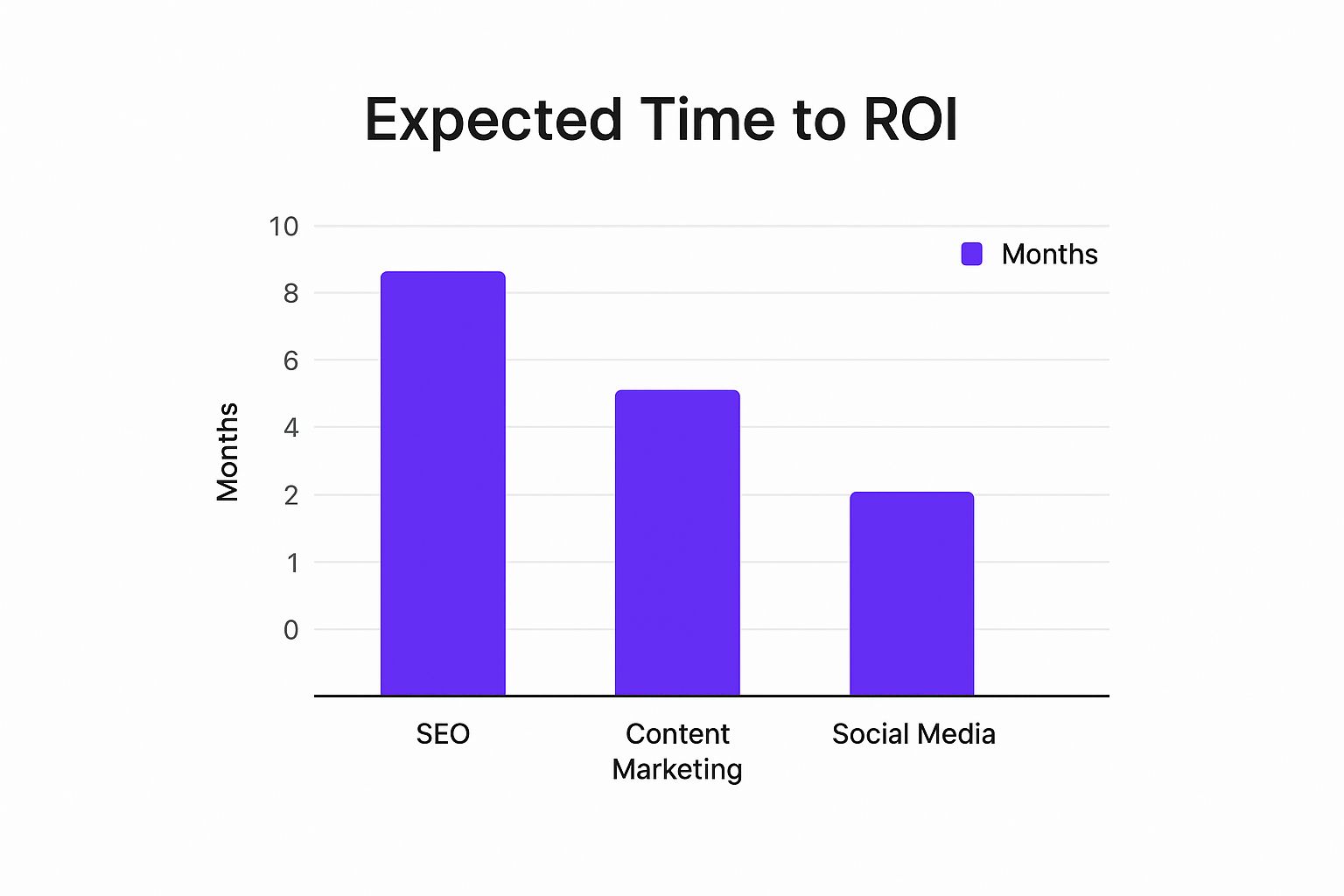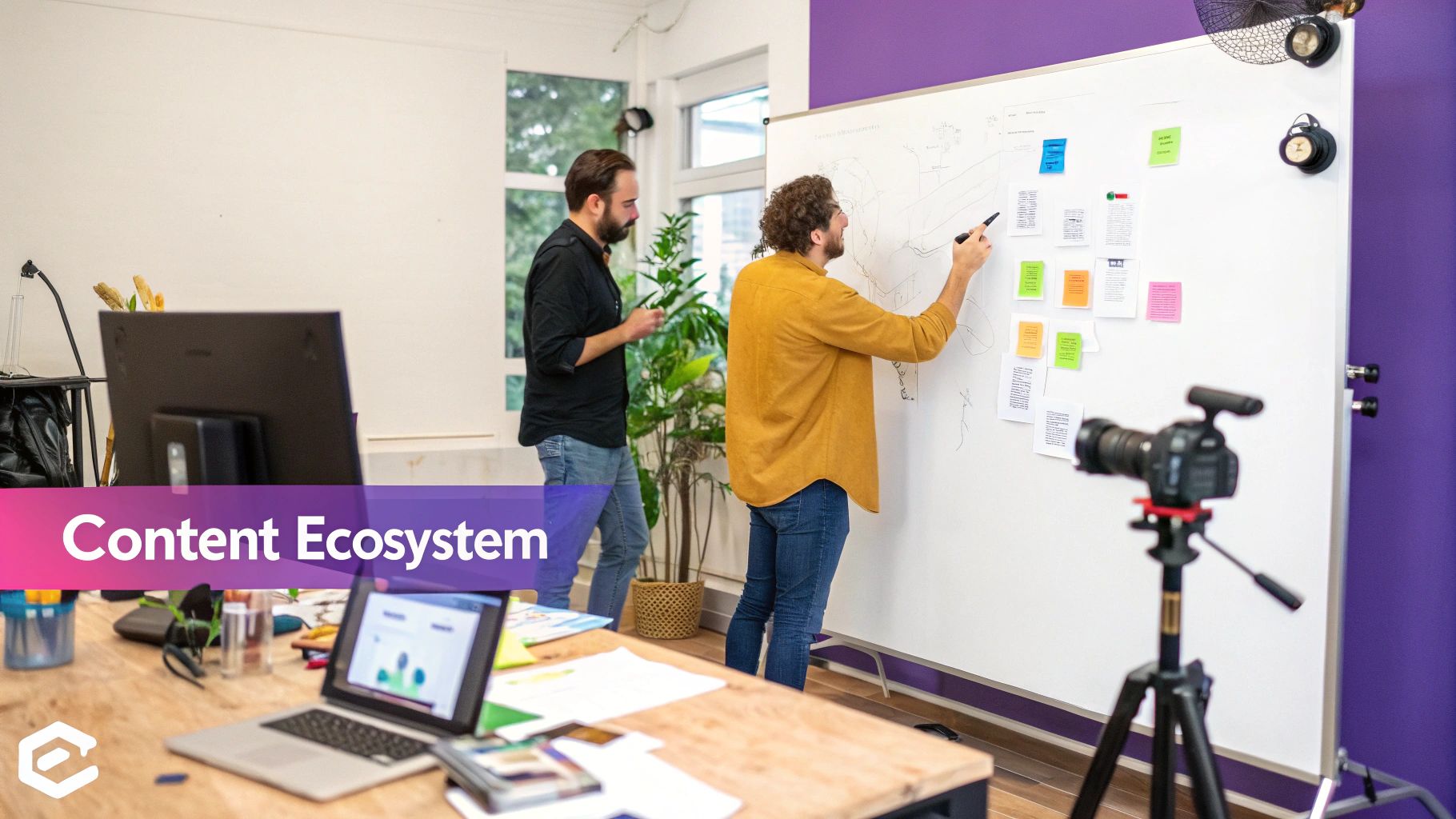How to Increase Website Traffic Proven Strategies
Getting more eyeballs on your website isn't about finding a single magic bullet. It’s about building a machine with a few different engines running at once. The smartest plays combine long-term foundation builders like search engine optimization (SEO) with authority-building content marketing and community-focused social media.
Paid ads can give you a quick shot of adrenaline, for sure. But for growth that actually lasts, you need a mix of strategies.
Your Foundation for Driving More Website Traffic
Before we jump into the nitty-gritty tactics, let's get the fundamentals straight. Every channel—SEO, content, social, paid—has a totally different job to do. Each comes with its own timeline, its own cost, and its own level of effort.
Putting all your eggs in one basket is just asking for trouble. What happens when a Google algorithm update tanks your rankings, or when ad costs skyrocket? A diversified approach means you’re not vulnerable to the whims of a single platform.
Thinking strategically about traffic means knowing which levers to pull and when. For example, SEO is the long game. It's an investment that builds a valuable asset over months and years, eventually delivering a steady stream of highly-qualified visitors. On the flip side, a killer social media campaign can create a burst of activity almost overnight, but it needs constant fuel to keep the fire going.
Setting Realistic Expectations
Patience is the name of the game here. You're not going to triple your traffic by next Tuesday, and each channel needs time to mature. This is where so many businesses get it wrong—they give up right before the magic happens.
Just look at the typical time it takes to see a real return on investment for the big three organic channels.

As you can see, social media can start delivering wins in as little as three months. SEO, however, is a marathon, not a sprint. You could be looking at nine months or more before you see truly significant results.
This isn't just theory; it’s a real struggle out there. A 2024 analysis found that while 43% of web analysts saw traffic increase year-over-year, low traffic is still a massive headache for small businesses. In fact, 21% cited it as their single biggest challenge. You can see more insights from the 2024 web traffic report to get the full picture.
The real goal isn't just more traffic; it's attracting the right traffic. A thousand window shoppers are less valuable than 100 people who are genuinely fired up about what you offer.
Traffic Generation Methods At a Glance
To help you decide where to focus your energy first, here’s a quick rundown of the main strategies, what they cost, and how long you’ll be waiting for results.
| SEO | Attract long-term organic traffic from search engines | Medium to High (tools, content, expertise) | 6-12+ months |
|---|---|---|---|
| Content Marketing | Build authority, trust, and attract leads through value | Medium (creation, promotion) | 3-9 months |
| Social Media | Foster community, drive engagement, and generate quick buzz | Low to Medium (time, creative, ads) | 1-3 months |
| Paid Advertising | Drive immediate, targeted traffic and conversions | High (ad spend, management) | Immediate |
| Partnerships | Tap into existing audiences for referral traffic | Varies (commissions, contra) | Varies |
Understanding the strengths and timelines for each of these methods is the key to building a resilient, multi-channel strategy. This foundational knowledge helps you put your resources in the right places, setting you up for consistent, meaningful growth down the road.
Mastering Search to Attract High-Intent Visitors

Organic search is your direct line to people who are already looking for what you sell. Forget just stuffing keywords onto a page; the real game is understanding and satisfying user intent. It’s about getting inside your audience's head to figure out the exact questions they're asking Google at 2 a.m.
When your content provides the best, most authoritative answer to those questions, you win. This is how you stop chasing fleeting clicks and start attracting high-intent visitors who are actually ready to convert.
And the impact is massive. Organic search drives 29% of all website visits, and with Google’s stranglehold on the market, visibility is everything. A wild 87.9% of users never even click past the first page of results, which is why a half-baked strategy just won't cut it. To see the full scope of search's power, check out the latest website statistics and trends.
Find and Dominate Long-Tail Keywords
Instead of getting into a street fight for broad, insanely competitive terms like "digital marketing," shift your focus to more specific long-tail keywords.
These are longer, more conversational phrases that reveal exactly what a user wants. Think "how to increase website traffic for a local bakery" instead of just "website traffic."
Sure, these terms have lower search volume individually, but they add up fast. More importantly, they attract a much more qualified audience. Someone searching for a specific solution is miles closer to buying than someone just browsing a general topic.
Here's where to start digging for gold:
- AnswerThePublic: A fantastic free tool that visualizes all the questions people are asking around your core topic.
- Google's "People Also Ask": This little section in the search results is a goldmine of related queries you should be answering.
- Online Forums: Poke around sites like Reddit or Quora. You'll see the exact language your audience uses to talk about their problems.
The secret to killer keyword research isn't finding terms with the highest volume. It's about finding the terms that signal the highest intent from your ideal customer.
On-Page SEO Essentials for Traffic Growth
Once you have your target keywords, you need to bake them into your content so search engines can understand and rank it. This is where on-page SEO comes in. It’s not about tricking algorithms; it’s about making your content clear, accessible, and valuable for both humans and search bots.
For a deeper dive, you can explore our comprehensive guide to search engine optimization services.
A great starting point is using a tool to check out a keyword's potential. This screenshot from Ahrefs shows how you can analyze a keyword to see its difficulty and potential traffic.

This kind of data is invaluable. It helps you decide which keywords are actually worth your time, balancing search volume against your realistic ability to rank for them.
Here are the critical on-page elements you absolutely must get right:
- Compelling Title Tags: Your title tag is the first thing a user sees in the search results. Make it descriptive and include your main keyword, but also write it to spark curiosity and earn that click.
- Optimized Internal Links: Sprinkle links to other relevant pages on your site throughout your content. This helps search engines discover more of your stuff and understand how your pages relate to each other, spreading authority across your site.
- Clean URL Structure: Keep your URLs short, sweet, and descriptive. A URL like yourdomain.com/increase-website-traffic is infinitely better than yourdomain.com/p?id=123.
- Fast Site Speed: A slow website is a traffic killer. Period. Use Google's PageSpeed Insights to test your site and find opportunities to shave off load time. Every second counts.
Creating Content That Earns Traffic

Let's get one thing straight: exceptional content is the engine behind any traffic strategy that actually works. Just tossing a new blog post into the void every now and then and hoping for the best? That's not a strategy; it's a lottery ticket.
The real secret is to stop thinking in terms of individual articles and start building a full-blown content ecosystem. This is how you transform your website from a random collection of posts into a go-to, authoritative resource in your niche. Ultimately, the goal is to master creating engaging content that gets results—content that doesn't just attract eyeballs, but turns visitors into fans.
One of the most powerful ways to build this ecosystem is the "hub and spoke" model, sometimes called topic clustering. It’s a brilliant way to organize your content, signal your deep expertise to search engines, and create a ridiculously smooth experience for your visitors.
Build Your Content Hub and Spoke Model
The hub and spoke concept sounds technical, but it’s actually pretty simple. You create one massive, central "pillar" page and then surround it with several related "cluster" pages that link back to it.
- Pillar Page (The Hub): This is your magnum opus on a broad topic. Think of a long-form, comprehensive guide like "The Ultimate Guide to Digital Marketing for Small Businesses." It covers all the essential subtopics without getting lost in the weeds on any single one.
- Cluster Content (The Spokes): These are shorter, laser-focused articles that dive deep into the specific subtopics you touched on in the pillar page. Using our example, cluster posts might look like "A Beginner's Guide to SEO" or "How to Run Your First Facebook Ad Campaign."
This structure is absolute gold for SEO. Why? Because every single cluster post links back to the central hub. This sends a massive signal to Google that your pillar page is the definitive authority on that topic, massively boosting its chances to rank for those big, juicy keywords.
Brainstorm Ideas That Solve Real Problems
Here’s the hard truth: traffic-generating content isn't about what you feel like writing. It's about what your audience is frantically typing into Google at 2 a.m. Your content must solve a real problem or answer a specific question they have.
So, put on your detective hat and start digging:
- Spy on Your Competitors: Use an SEO tool to see which articles are sending the most traffic to your competition. Find the gaps. Can you create something more detailed, more current, or just plain more helpful?
- Talk to Your Sales Team: Seriously. Your sales and customer service folks are on the front lines every day. They know the exact questions, roadblocks, and frustrations your potential customers are dealing with.
- Mine Online Hangouts: Go lurk on Reddit, Quora, and industry forums. The raw, unfiltered conversations happening there are a goldmine for understanding your audience’s biggest challenges in their own words.
A single piece of truly great content is worth more than ten mediocre articles. Always, always focus on quality over quantity. Your mission is to become the definitive resource, not just another voice in the crowd.
Strategically Repurpose Your Best Content
Look, creating a high-quality pillar page is a ton of work. Don't let all that effort die the second you hit "publish." You can squeeze so much more traffic out of a single core asset by repurposing it into a bunch of different formats.
This isn't just about saving time; it's about extending your reach and appealing to people who prefer different types of media.
For instance, that one comprehensive guide can be chopped up and reborn as:
A slick infographic summarizing the key stats.
A series of short, punchy video clips for social media.
A handy checklist or worksheet you offer as a lead magnet.
A presentation deck for a webinar or SlideShare.
When you start thinking this way, you're not just writing blog posts anymore. You're building a powerful, interconnected web of resources that cements your authority, drives a steady flow of organic traffic, and keeps people hooked. For more inspiration, check out this excellent content marketing strategy template.
Using Social Media for Community and Clicks

Let's clear something up: social media isn't a megaphone for shouting about your latest blog post. It's a tool for building a genuine community—one that actually trusts you, engages with your content, and loyally clicks back to your website.
Forget the pressure to be everywhere at once. The real secret to driving traffic from social media is to be surgically strategic. Instead of spreading your energy thin, pick the one or two platforms where your ideal audience actually lives. A B2B software company will find its people on LinkedIn, not TikTok. A home decor brand, on the other hand, will kill it on Pinterest and Instagram. Focus your firepower where it counts.
From Social Post to Website Visit
The bridge between a casual scroll and a click to your site is built with pure curiosity and value. Just dropping a link with a lazy "new post" caption is a recipe for being ignored. Your job is to make clicking through an irresistible next step in a conversation you've already started.
Treat every social media update as its own mini-piece of content. Don't just regurgitate the blog title; pull out a surprising statistic, a spicy quote, or a game-changing takeaway from your article.
- Create Custom Visuals: A unique graphic or a quick video clip designed for that specific platform will grab way more attention than a generic stock photo ever could.
- Write Captions That Spark Conversation: Ask a direct question. If your article is about productivity, ask, "What’s the one productivity hack you can’t live without?" Get people talking.
- Use Platform-Specific Features: Get smart with the tools each platform gives you. Leverage Instagram Stories with "link" stickers, build out insightful Twitter threads, or drop thoughtful questions in relevant LinkedIn groups.
Your social media feed should be a value-packed preview of the even greater insights waiting on your website. Tease the best parts of your content to make people feel like they have to know the rest of the story.
Engage Beyond Your Own Feed
A massive, often-missed opportunity for driving traffic lies outside your own profile. You need to actively participate in the digital communities where your audience already hangs out. This means jumping into relevant Facebook groups, answering questions on Quora, or contributing to discussions in industry-specific subreddits.
The key here is not to spam your links. Nobody likes that person. Provide genuine, helpful answers and insights first. Once you've established yourself as a valuable contributor, you can naturally mention a resource on your site that offers a deeper dive. For a closer look at effective strategies, check out these social media marketing best practices.
This approach frames your website as a helpful resource, not just another sales pitch. When you build that kind of trust, you’ll attract highly motivated visitors who are already primed to engage with what you have to offer. For more guidance, our guide on social media marketing for businesses offers a detailed roadmap.
Your Website Must Be Built for Mobile Visitors
Your website might look incredible on a 27-inch desktop monitor, but that's not where most of your audience lives. The modern internet fits in a pocket, and if you’re not optimizing for mobile, you're not just making a small mistake—you're slamming the door on a massive chunk of your potential traffic.
This isn’t just a trend; it's the standard. Google's mobile-first indexing means it primarily uses the mobile version of your site for ranking. If that version is slow, clunky, or just plain broken, your search visibility gets tanked across the board. You're essentially cutting off a huge pipeline of visitors before they even find you.
The numbers don't lie. Mobile now accounts for 59.7% of all website visits worldwide, a massive jump from just 35% back in 2015. The writing is on the wall: if your site isn't built for a phone screen, you're actively choosing to ignore the majority of your potential audience. You can see more mobile traffic stats and insights over at tekrevol.com.
A Flawless Mobile Experience Is Non-Negotiable
Having a "responsive" design that just shrinks to fit a smaller screen isn't nearly enough anymore. You need to be completely obsessed with the user experience from a mobile perspective, putting speed and simplicity above all else.
Think about the context of your user. They're probably browsing with one thumb while waiting for a coffee. They don't have time for complicated menus, tiny buttons they can't tap, or forms that take forever to fill out. Any friction leads to an instant exit. Your job is to hunt down and eliminate every single one of those frustrating moments.
A great first step is to audit your site like a real mobile user. Don't just rely on your browser's developer tools. Pull out your own phone, navigate to your most important pages, and try to complete a key action, like filling out a contact form or buying something. You'll quickly see where the roadblocks are.
Actionable Fixes for Common Mobile Headaches
You don't need a complete site overhaul to see major improvements. Focusing on a few high-impact areas can make a world of difference in how mobile visitors see and interact with your site.
- Prioritize Above-the-Fold Content: Get your most important message and call-to-action visible without any scrolling. Mobile users have zero patience for hunting around.
- Simplify Your Navigation: A clean "hamburger" menu is your best friend. Make sure your links are big enough for a thumb to tap easily, with plenty of space between them to prevent mis-clicks.
- Crush Your Page Speed: Huge image files are the number one killer of mobile load times. Compress every single image and minimize your code (CSS and JavaScript) to make your pages load in a flash.
- Streamline Your Forms: Nobody wants to fill out a 20-field form on their phone. Keep forms brutally short. Use mobile-friendly keyboards (like the number pad for phone numbers) and consider breaking longer forms into a few simple steps.
Your mobile site isn't just a smaller version of your desktop site; it is your site. Give it the focus it deserves, and you'll be rewarded with better rankings, happier visitors, and a lot more traffic.
Got Questions About Driving Traffic? We’ve Got Answers.
Jumping into the world of traffic generation can feel like you’re trying to drink from a firehose. A lot of businesses and creators hit the same walls and ask the same questions. Let’s clear the air and tackle some of the big ones so you can move forward with confidence.
How Long Does It Really Take to See SEO Results?
This is the million-dollar question, and the honest-to-goodness answer is: it's a marathon, not a sprint. While you might see a few little bumps from on-page fixes within a few weeks, you're typically looking at 4 to 12 months for significant, stable organic traffic growth.
Why the huge range? A few things are at play:
- Your Starting Point: A brand-new website is starting from ground zero. An established domain with some history has a serious head start.
- The Competition: Trying to rank for "local artisanal dog treats in Boise" is a heck of a lot faster than going after "best small business loans."
- Your Hustle: Your results are a direct reflection of how consistently you’re creating killer content and earning quality links.
Think of it this way: you’re building trust and authority in Google’s eyes, and that doesn't happen overnight. The payoff, though, is a steady stream of high-intent visitors that keeps showing up long after you’ve done the work.
Should I Pour Money Into Paid Ads or Just Stick to Organic?
This isn't an "either/or" decision. The smartest play is a "both/and" strategy that matches your immediate needs with your long-term vision. It’s all about balancing quick wins with building a lasting asset.
Paid ads deliver instant traffic. They’re brilliant for a product launch, a holiday sale, or to quickly validate a new offer. The second you turn off the spend, however, that traffic disappears into thin air.
Organic traffic from SEO and content marketing is a long-term investment. It takes time, sweat, and patience to build, but you're creating a durable asset that can pull in "free" visitors for years. A great strategy uses paid ads to get early traction and data while the slow-and-steady power of SEO builds the foundation.
The most effective strategies don't pit paid and organic against each other. They use the speed of paid ads to gather data and drive immediate results while the compounding power of SEO builds a lasting foundation for growth.
What Are the Biggest Traffic-Killing Mistakes to Avoid?
Knowing what not to do is just as critical as knowing what to do. One of the absolute biggest blunders is chasing traffic for traffic's sake. Getting thousands of visitors who have zero interest in what you offer and bounce immediately is a vanity metric. It does nothing for your business.
Beyond that, here are a few other landmines to sidestep:
Ignoring Technical SEO: A slow site, broken links, or a confusing layout will stop both users and search engines dead in their tracks.
Forgetting About Mobile: Most people are on their phones. If your site is a nightmare on mobile, you’re actively turning away the majority of your potential audience.
Creating Content That Misses the Mark: If your content doesn't actually answer the questions your audience is searching for, you're just shouting into the void.
Buying Sketchy Backlinks: This is an old-school, risky tactic that can get you slapped with a nasty Google penalty, wiping out all your hard work overnight.
Hitting 'Publish' and Praying: Publishing is step one. You need a solid plan to actively promote your content and get it in front of the right eyeballs.
Steering clear of these pitfalls is a non-negotiable for anyone who's serious about building website traffic that actually matters.
Ready to stop guessing and start growing? The expert team at Rebus builds data-driven marketing strategies that deliver real results. Partner with us to turn your traffic goals into a reality. Learn more about our services.
